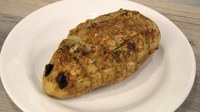Prairie Fare: Gardening Delights Children and Promotes Good Nutrition
(Click an image below to view a high-resolution image that can be downloaded)
By Julie Garden-Robinson, Food and Nutrition Specialist
NDSU Extension Service
I felt like a magician the other day, but I wasn’t pulling a rabbit out of a hat.
I pulled three radishes out of the ground in a children’s garden, much to the delight of the preschoolers. One radish was red, one was light purple and one was white.
The radishes were supposed to be those colors, by the way. We have interesting varieties of radishes, carrots and other vegetables available to plant.
As the children looked in wonderment at the food coming out of the ground, the situation reminded me of my 18-year-old daughter in her younger years. She liked to examine the plants in our garden, sometimes on an hourly basis.
“Aren’t they ready yet?” she asked, pointing at the abundant foliage in several container gardens on our deck. She was about 8 at the time.
“Potatoes take a long time to grow,” I answered.
“But they’re really big and they have flowers!” she noted enthusiastically as she studied the potato plants in a half-barrel planter.
I thought I might have to throw my body over the planter to protect the plants from being pulled out of the soil by my daughter.
“We need to be patient, and our potatoes will be worth the wait. We will have tomatoes and peppers very soon, though. We can try a bell pepper. Let’s visit the farmers market for some fresh corn, too,” I replied.
She was quite amazed when we dug the potatoes. I had planted purplish-blue potatoes.
Through the years, I have involved my kids in planting, preserving and cooking foods we grew, just as I helped my parents. My little experiment at home has paid off with adolescents and a young adult who eat their vegetables.
Researchers have shown that children who help tend to a garden eat more vegetables as a result.
Even if you don’t have a garden, you may have the opportunity to enjoy fresh, locally grown fruits and vegetables at the many farmers markets and roadside stands that are sprouting across the region. Some grocery stores also sell locally grown produce.
Farmers markets are fun to visit and provide delicious beginnings for family meals. They give children an opportunity to learn about food, nutrition and food preparation if you enlist their assistance.
According to MyPlate, which is the current icon of healthful eating, we need about 2.5 cups of vegetables and 2 cups of fruit daily to meet the recommendations.
Many people shortchange themselves on dark green and orange vegetables, so be sure to make those a priority. Dark green leaf lettuce, spinach, broccoli, squash and pumpkins can fill that void and provide a variety of vitamins and minerals in our diet.
The rest of the rainbow of fruits and vegetables also have health benefits. See https://www.ag.ndsu.edu/pubs/yf/foods/fn595.pdf to read “What Color is Your Food?”
Try these tips to help you choose the best quality produce and other foods at a market. Select an amount that you can use within a short time to avoid spoilage and waste.
- If you’re picking your own, be sure to bring clean containers or bags.
- Look for produce that is free from unusual odors or colors and signs of spoilage, such as mold.
- Handle produce gently to reduce bruising. Bacteria can thrive in the bruised areas.
- Don’t worry if the fresh produce is not “picture perfect” in shape and size. It still has the same nutrition.
- When buying cut produce, be sure it’s refrigerated and keep it cold during transport. Keep it in a cooler with ice if traveling a long distance.
- If custard-containing fruit pies are for sale at an outdoor food stand, be sure they haven’t been allowed to stand in the sun. These are perishable items and should be stored cold.
I didn’t have this recipe with kid appeal back in the days when my daughter was watching potatoes grow, but she still loves potatoes. Potatoes are among the best sources of potassium, plus they have many other nutrients.
Potato Hedgehogs
4 medium russet potatoes
2 Tbsp. canola oil
1 Tbsp. ranch seasoning mix
Handful raisins
Preheat oven to 425 F. Wash and dry potatoes. Leaving one-fourth of the potato uncut (to form the head), use a knife to make cuts lengthwise along the potato about two-thirds of the way deep. Turn potato and make cuts across two-thirds of the way deep. You should have a checkerboard pattern. Repeat the process with remaining potatoes. Mix oil and seasoning in a bowl. Brush each potato with the oil mixture. Bake for 45 minutes or until potatoes are tender. The cuts should separate slightly to form the hedgehog’s prickles. Allow to cool for a few minutes. Using a small knife, cut two crosses on the head portion for eyes. Put the raisins into each cross. Serve immediately.
Makes four servings. Each serving has 250 calories, 7 grams (g) fat, 5 g protein, 43 g carbohydrate, 4 g fiber and 15 milligrams sodium.
(Julie Garden-Robinson, Ph.D., R.D., L.R.D., is a North Dakota State University Extension Service food and nutrition specialist and professor in the Department of Health, Nutrition and Exercise Sciences.)
NDSU Agriculture Communication - July 7, 2016
| Source: | Julie Garden-Robinson, 701-231-7187, julie.garden-robinson@ndsu.edu |
|---|---|
| Editor: | Ellen Crawford, 701-231-5391, ellen.crawford@ndsu.edu |



